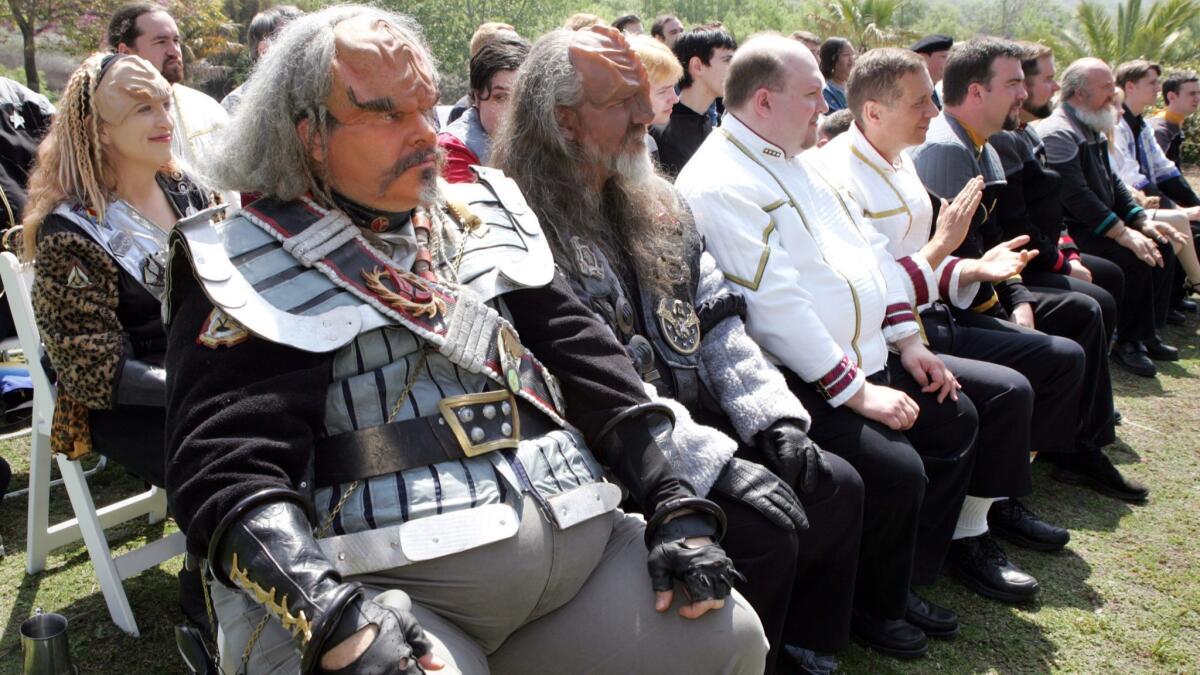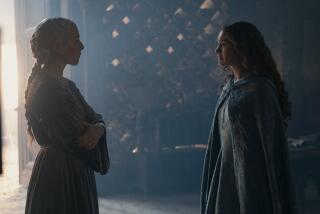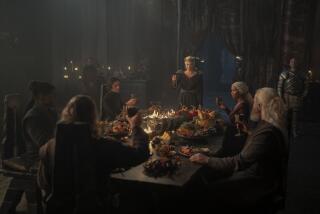10 essential ‘Game of Thrones’ fan films reviewed: most professional to most lovable
I am a fan of fandom. The creative passion an audience brings to its relationship with culture — a series of books, a pop group, a film franchise or a television show — interests me as much, and sometimes more, than things themselves. “Game of Thrones,” whose final season is about to begin, is a case in point.
Almost by definition, the producers of popular series cannot supply enough new material to satisfy their fans’ demand. Last season’s “Game of Thrones” was only seven episodes — that is to say, 45 weeks out of that year there was no new episode of “Game of Thrones.” And excepting last year’s “imaginary history” “Blood & Fire,” it has been eight years since George R.R. Martin published a new installment of “A Song of Ice and Fire,” the series of books on which the TV show is based.
And so fans step in to relieve the shortfall. They make their own stories to fill the gap, writing fan fiction, making fan films — which are just the non-canonical, unsanctioned, less expensive version of what the proprietors of “Star Wars” and “Star Trek” do with their sequels and prequels and such. Sometimes it is a matter of building out the universe in a way the creators would never bother to do; sometimes, as with the romantic fictions called “shipping,” it’s to create relationships they would never sanction; sometimes it’s to make a franchise look a little more like your own life.
Some fan films are just mad projects, like Alisa Stern’s brilliant and adorable stop-motion “Doctor Who” series, “Doctor Puppet,” (2012-14) and Dan Lanigan’s 2016 “Fan-O-Rama,” a bizarrely accurate translation of Matt Groening’s animated “Futurama” into live action, with Rich Little as the head of Richard Nixon. Respect.
Complete Coverage: ‘Game of Thrones’ the final season »
Any literate person with a pencil and paper can write fan fiction; movies take a few more tools. But the increasing capability and affordability of cameras and software — not to mention online crowd-funding — has allowed motivated civilians to create credible, even incredible, screen versions of big-budget productions.
And where they are not quite credible, they can still be wonderful. Indeed, much of what makes fan films interesting comes exactly where they fall short, when the rivets show and the seams are open; it lets the effort and energy and love show through. The aspirational nature of these works makes excellence beside the point; it’s the striving that counts.
Kids with cameras have created homemade takes on their heroes since cameras were available; most are lost to time, spring cleaning or the absence of anything to show them on. But with YouTube and its like, projects that would have once been seen by a few can be distributed globally. There have been 5½ million YouTube views of the Harry Potter fan film “Severus Snape and the Marauders” and more than 15 million for the Italian-made “Voldemort: Origins of the Heir.”
Big-league fan filming arguably begins with Michigan carpet layer John Consentino’s 1974 Super 8 feature “Star Trek” homage, “Paragons Paragon,” which launched a genre: Now there is an annual award for “Star Trek” fan films, the Bjo Awards, named for Bjo Trimble, who was behind the campaign that saved the first series from cancellation.

More recent productions include the series “Star Trek Continues,” which replicates the feel, and what might be called the intellectual approach, of the NBC original and the 50-episode “Star Trek: Hidden Frontier,” with dodgy green-screen effects and an endearing air of community theater.
Not surprisingly, most fan fiction focuses on fantasy and science fiction, genres with large casts, complicated histories and plenty of room for world-building. “Game of Thrones” is especially well-suited to this sort of elaboration. Much of its audience is versed in improvising on fantastic medieval motifs and themes, having grown up playing Dungeons and Dragons or engaged in multiplayer online video games or real-world LARPing or just dressing for the Renaissance fair. In some cases there are professionals involved, but on the whole, fan films are more play than work. Performers don’t just act their roles, they enact them, knitting themselves into a world.
HBO has its own, starry “GoT” sequel in the works. But as long as fans remain, someone will be suiting up in fur or armor to make new episodes. I have spent some time combing through the available supplements. Here is my report.
Most “Game of Thrones” fan films are on the short side. Some involve not much more than a character or two wandering the wilderness until someone — or something — attacks them, the better to display their typically impressive swordsmanship. Most are shot largely or entirely out of doors, dispensing with the need for sets. It helps to live near woods, preferably somewhere it snows. Having a horse is good; access to a castle, even better.
“Nights Watch” (2016, 3 ½ minutes) and “The Red Kraken” (2017, 4 minutes) are as basic as it gets. With casts that double as creators, they are essentially fight scenes with a little bit of preamble. The first is set in the snow (“It was below freezing when we filmed it, so we got the full experience of being in the North”), the second on a beach. A little more complicated is “The Red Letter” (2013, 4 minutes), subtitled “A Game of Thrones Fan Film ft. The Red Wedding” (it is only Red Wedding-adjacent), which juxtaposes two fight scenes, keeping a man and a woman from their appointed rendezvous. There is a little more conversation in this one, on the way to most everyone being dead at the end.
“Tower of Joy” (2016, 4 minutes) expands an episode only briefly sketched in Martin’s books, and partly pictured on the HBO series, when young Ned Stark (played by Hollywood stunt man and Medieval Times performer Jeff Odachowski) to the round tower came with six companions to fight three members of the Kingsguard. But it also follows Ned into the tower for an Important Moment. Shot in the grandly scenic hills north of Los Angeles, a decent match for the Spanish countryside of the series’ version.
The animated “The Doom of Valyria” (2017, 20 minutes), from Inez Kratman and Patrick McCarthy, is clear about its aims. “The intention of the video,” reads an opening title, “is to be bought and produced by HBO as a spin-off/prequel of ‘Game of Thrones’ as a live-action drama,” although it says this all in capital letters and without punctuation. This well-written, nicely acted “pilot” finds Ben Stark (I don’t know which, there are so many Ben Starks) traveling to a pre-cataclysm Valyria for the wedding of siblings Daenys and Gaemon Targaryen. (It fudges the incest question.) As a cartoon — a pretty basic one, often awkward, but sometimes sort of eloquent — it can bring in multiple grand settings and a range of characters. And dragons. There’s no fighting — it is a talky 20 minutes — but, quite in the spirit of HBO, there is nudity and sex.
“Shot on a Nikon D750 with various lenses,” Ruman Hamdani’s wordless “The Cure: A Kashmiri Instrumental Tribute to Game of Thrones” (2018, 6 minutes) is the artiest, most self-consciously beautiful of the lot. Shot in Kashmir, at a ski resort, with Kashmiri actors and musicians performing the “Game of Thrones” theme on traditional instruments (in the snow, like the Beatles in “Help!”), it’s essentially a music video with, I guess, a plot. I would have to watch it a couple more times to tell you just what it is. Includes a Peter Dinklage look-alike.
From Germany comes “Frozen Rivers” (2017, 27 minutes), a wholly invented scenario involving friends and lovers, betrayal and treason. It’s ambitious and amateurish in equal parts, with inconsistent sound and camerawork; the acting of its young cast — it’s been sponsored by the Catholic University of Eichstätt-Ingolstadt, surprisingly — varies from hesitant to excessive, and to an American ear the accents can sound comical. The mood is dark, profane and violent, but there’s also a throwaway gag about posture; a briefly glimpsed scroll with a list of names that includes Albus Dumbledore, Hannibal Lecter and Vladimir Putin, and a joke (popular among fans, I guess, since I have found it elsewhere) about Jaime Lannister not being able to come to your aid because he lost his helping hand.
Out of Canada is the technically excellent “A Tale of Benjen Stark” (2013, 6 minutes). Not much story here — Benjen (Yves Pelletier) stumbles on the remains of a massacre at a wildling camp, meets a couple of survivors, and then the killers — but lots of style, and snow, with attention paid on every level of production and post-production. (Director Benjamin Von Wong is a professional photographer who specializes in effects.) Includes a severed head, a horse that rears up like Trigger and its own “behind the scenes” documentary.
The all-round best of the lot is “The Wild Wolf” (2017, 16 minutes), directed by Ciaran McIlhatton, who can claim an actual “GoT” credit — “camera trainee” — and written by McIlhatton and Shane Gibson, who also stars. It has the benefit of being made close to the source, “with volunteers from the local media circles in Belfast and Northern Ireland to showcase some of the local talent on offer.” The scenery is spectacular; you get a horse, a castle, a river and a passel of background actors, and the Irish accents are come by naturally. We see characters in their youth, along with characters dead before “Game of Thrones” begins, as Brandon Stark (Gibson, with a face fit for HBO), about to marry Catelyn Tully (Elisha Gormley), finds himself in a duel with Petyr Baelish (Curtis Worrell), a.k.a. Littlefinger, who likes her more. The acting is first-rate, there’s a good bit of narrative before the swordplay starts, and the swordplay has a dramatic complexity not seen elsewhere.
My own favorite is the least accomplished, but certainly not the least earnest: 2018’s “Winds of Winter” (11 minutes) which takes the title of Martin’s unfinished next “Ice and Fire” novel. Written and directed by, and also co-starring “Chandler S.,” with free borrowings from the HBO series any jury would find to be “fair use,” it is the work of middle-schoolers, their furry cloaks and capes given a certain poignancy by their contrasting jeans and tennis shoes. I like their “adult” seriousness — they are playing grown-ups, after all --- and also the childlike lapses in their seriousness: In spite of the dark and dire tale they present, they are also clearly having fun. Smiles sneak out.
Follow Robert Lloyd on Twitter @LATimesTVLloyd
More to Read
The complete guide to home viewing
Get Screen Gab for everything about the TV shows and streaming movies everyone’s talking about.
You may occasionally receive promotional content from the Los Angeles Times.







